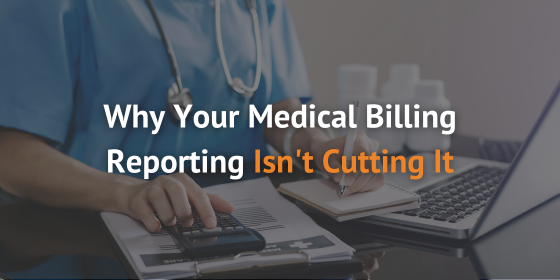
Why Your Medical Billing Reporting Isn’t Cutting It
In the medical billing world, accurate and efficient billing processes not only ensure a steady revenue stream, but also foster trust between providers and patients. As healthcare regulations become increasingly complex and reimbursement models continue to evolve, the need for robust medical billing reporting has never been more critical.
However, despite the advancements in healthcare technology, many medical practices and billers find themselves grappling with subpar medical billing reporting that fails to meet their needs. These shortcomings can lead to revenue leakage, operational inefficiencies, and a loss of valuable insights for informed decision-making. In this blog, we dive into some of the reasons why your medical billing reporting may not be getting the job done.
1. Inaccurate or Incomplete data: One of the most significant issues in medical billing reporting is the presence of inaccurate or incomplete data. This can lead to incorrect claim submissions, denials, and payment delays, negatively impacting the revenue cycle. Your medical billing reporting should be trustworthy and reliable, in addition to being timely. The value of real-time reporting cannot be overstated. Delayed reporting can result in missed opportunities for addressing claim denials or underpayments promptly, leading to potential revenue loss. Your business should have no tolerance for inaccurate reporting.
2. Lack of Standardization: Medical billing involves various codes, regulations, and guidelines, such as CPT (Current Procedural Terminology) codes, ICD-10 codes, and payer-specific rules. The lack of standardization across different systems can lead to confusion and errors in reporting. The last thing your business needs is avoidable mistakes in its reporting. No standardization makes your business far more prone to these errors.
3. Lack of Customization: A major shortcoming of most medical billing software is the lack of an ability to personalize reports, and create them from scratch. Your business is unique, and you likely want to create unique reports and use data in different ways. Your software should not hold you back in this regard.
Customization is one of EZClaim’s strongest functionalities. Our robust medical billing software enables you to customize reports, create reports from scratch, and leverage tools like grid customization to create the exact report you need.
4. Failure to Track Claim Status: Many billing systems lack proper mechanisms to track the status of claims effectively. This can lead to a lack of visibility into the progress of claims and hinder the identification of potential issues. If your business is in the dark as to the status of its claims, it makes it incredibly difficult to project results and accurately forecast performance.
5. Limited Insights: Inadequate reporting tools and analytics can impede the ability to gain actionable insights from billing data. Bad data means bad insights. If your medical billing reporting is ineffective, you will not be able to use your data to draw actionable conclusions that will make your billing process more efficient. Without accurate insights into performance, it is incredibly difficult to improve your billing process.
6. Insufficient Integration: Integration between your EHR and billing software is critical for seamless data flow. Poor integration can lead to data discrepancies and duplicate entries. Ensure your billing system integrates with your EHR to ensure there isn’t any disconnect in your processes.
Is your business getting the most out of its medical billing reporting? If the answer is no, we’d love to speak with you! EZClaim is the solution of choice for practices and outsourced billers alike thanks to our easy-to-use interface and comprehensive billing features. Our mission is to make the medical billing process as simple as possible for your business. If you are interested in learning more, we encourage you to schedule a free consultation with our team!




